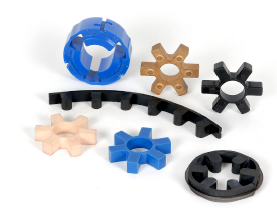Elastomers In Compression
We features 4 types of elastomer styles to allow for more flexibility in addressing certain application necessities. One piece designs are utilized in the “L” and “AL” designs (known as spiders) and many portion 
Solid Center Spider
The strong center style is frequently utilised layout when shafts on the driver and driven equipment may be kept separate by a conventional gap
Open Center Spider
The open center design and style makes it possible for for that shafts on the driver and driven for being positioned inside of a short distance
Open center spiders supply shaft positioning versatility but have a lower RPM capability
Cushions
Utilized exclusively to the C and H Kind couplings
Load cushions are held in spot radially by a steel collar that is attached to on the list of hubs
Snap Wrap Flexible Spider
Layout makes it possible for for quick elimination from the spider devoid of moving the hubs
Enables for close shaft separation the many way up to the hubs highest bore
Greatest RPM is 1,750 RPM together with the retaining ring, but if utilised with all the LC Type (with collar) the normal RPM rating with the coupling applies
Style is available in NBR and Urethane only, and in restricted sizes
Spider Supplies
SOX (NBR) Rubber
The typical materials that may be really flexible material that is certainly oil resistant
Resembles pure rubber in resilience and elasticity, and operates efficiently in temperature ranges of -40° to 212° F (-40° to 100° C)
Urethane
Has one.five instances better torque capacity than NBR
Superior resistance to oil and chemical substances
Materials gives less dampening result and operates at a temperature choice of -30° to 160° F
Hytrel
Flexible elastomer intended for substantial torque and high temperature operations
Operates in temperatures of -60° to 250° F (-51° to 121° C)
Bronze
Rigid, porous, oil-impregnated metal insert exclusively for lower speed (max 250 RPM) applications requiring large torque abilities
Not affected by water, oil, dirt, or intense temperatures – operates in temperatures of -40° to 450° F (-40° to 232° C)
